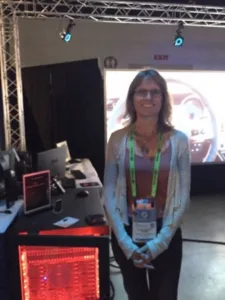Ford’s VR Specialist (Visionary) Elizabeth Baron stands in front of the best darn display at Siggraph includes a 100-inch Barco dual laser image and work of love that was 5 years in the makingAnother new display milestone at Siggraph was shown in the Ford Booth, which showed its ‘Immersive Vehicle Environment’. This included crunching 120M polygons rendered real-time, in a 4K immersive 3D environment, to deliver a full-sized virtual vehicle for engineering and development evaluation. Remarkably, the virtual/front projection display system included ray tracing, adding a dramatic highlighting effect that no less than stole the Best Image of the Show (OK it’s subjective, but you had to see this to believe it). Located in the Emerging Technologies section of the VR village, the company showed what Ford’s VR Specialist (we call her a visionary) Elizabeth Baron dubbed, “The highest level of visual fidelity shown to date.” We concur unequivocally. This is part of Ford’s new ultrahigh-definition, virtual reality lab created to enable designers in Michigan, Palo Alto and Melbourne, Australia to collaborate real-time on vehicles using a complete engineering data set.
To deliver the projected image the company convinced Barco, with the help of system integrator IGI, to ‘soft launch’ its newest Xenon front projector powerhouse, the DP4K60L: the world’s brightest projector. It’s a native 6-primary colour dual-laser-light system, with 4096 x 2160 resolution. The unit boasts the title of first laser projector capable of showing DCI-4k content at 60 fps, plus 3D films in full 4k resolution. Brightness hit 56K lumens at 2,500:1 native contrast. Yes, according to Ford’s Baron, it’s the projector’s first ever public showing. But that was just the big image. The company included a 100″ Barco screen (rigid), which successfully eliminated any hint of speckle. The image in the booth was simply fantastic.
Baron told us the key to the immersive environment was delivering the engineering data set, first developed in Catia (Dassault Systems) then moved to TeamCenter (data management tool) where it was “materialised” in 4k and lives in a super computer/server.
Both the NVIS 1280 x 1024 3D VR headset and Barco projector were connected to a Devil and Demon compact super computer hosting 26 Intel Xeon processors, running at 2.3 GHz. That’s a total of 468 CPU cores, and 936 total hyper threads. Memory included an 896GB Micron DDR4 2133 MHz RAM and NVIDIA K6000 GPU with up to 24TB Micron SSD storage (dang!), all used to drive the complete engineering data set of the 2015 Ford Mustang GT. The VR content build process includes direction from Ford’s Dr. Richard Zavodsky, and Ford’s body construction engineer Janice Goral according to IGI’s data the group provided on the project.

